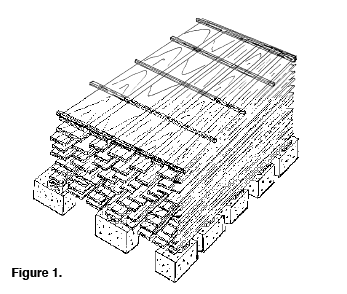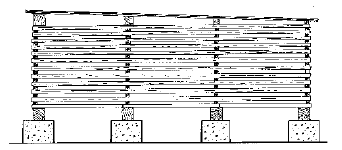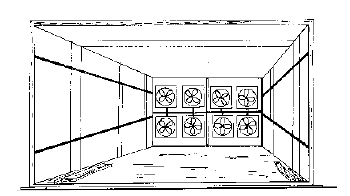Practicalities in Air-Drying Lumber
The drying of lumber is an important process that is required for the efficient use of wood products. A freshly harvested tree will have a significant amount of moisture trapped within the wood cells. For example, a 17 foot log that is 18 inches in diameter at breast height with several inches of sapwood can have approximately 130 gallons of water in its cells. This water represents more than half the total weight of the log. Any lumber manufactured from such a green log will have a high moisture content making it unsuitable for many applications. Proper gluing and finishing are not possible until the moisture content is reduced to an appropriate level. Other advantages of drying include weight reduction, increased strength, and greater resistance against biological deterioration due to fungi and insects. This fact sheet summarizes some of the practical aspects related to air drying lumber.
While kiln drying is usually necessary for lumber to reach the low moisture content needed for bonding or finishing, it is possible to reduce moisture content significantly by air-drying, which involves exposing piled lumber to ambient outdoor conditions.
The main objective of air drying is to evaporate as much moisture from the lumber as possible. Unlike kiln drying, air drying offers little control of the rate of drying and the final moisture content. With air drying, lumber is typically left on stickers in the yard until a moisture content of approximately 20 percent is reached. Drying rate and time depend on environmental conditions such as air circulation rate, temperature, and relative humidity of the outdoor air. The required air-drying time is longer for all species than kiln drying time. Table 1 displays average air-drying time for lumber of various species with one inch thickness. Air drying is ideal for lumber that is going to be used for a high moisture content application, or as a pre-drying method for kiln drying. Although drying parameters in air drying are not as fully controlled as they are in kiln drying, the relationship between the quality of dry lumber and the drying process should not be overlooked. Lumber quality and drying time are directly related to the beginning moisture content of the lumber and to the moisture content difference between that of the wood and the surrounding environment. Wood loses and gains moisture in an effort to reach equilibrium with the surrounding environment. Moisture content of wood at this point is called the equilibrium moisture content (EMC) and is a function of the relative humidity of the surrounding air. Relative humidity is the ratio of the amount of water vapor present in a quantity of air to the maximum amount of water vapor air can hold at the same temperature. Relative humidity is measured using a hygrometer that consists of both wet and dry bulb thermometers. Wet bulb temperature will usually be lower than that of the dry bulb due to evaporation, which takes place on the damp wick of the wet bulb. Based on the difference between these two temperatures, relative humidity can be determined from Table 2. For example, if the wet bulb and dry bulb temperatures are 70°F and 75°F, respectively, the relative humidity will be 78 percent.
Table 1. Average air drying time for various species.
| Hardwoods | Drying Time (Days) | Softwoods | Drying Time (Days) |
|---|---|---|---|
| Red oak | 70-200 | Douglas fir | 20-200 |
| White oak | 80-250 | Eastern hemlock | 90-200 |
| Big leaf maple | 60-180 | White pine | 60-200 |
| Red maple | 30-120 | Redpine | 40-200 |
| Silver maple | 30-120 | White spruce | 30-120 |
| Sugar maple | 50-200 | Sitka spruce | 40-150 |
| Birch | 50-200 | Western larch | 60-120 |
| Beech | 70-200 | Loblolly pine | 30-150 |
| Aspen | 50-150 | Engelmann spruce | 20-120 |
| Ash | 60-200 | Sugar pine | 15-90 |
| Alder | 20-180 | Redwood | 60-185 |
| Yellow poplar | 40-150 | Ponderosa pine | 15-150 |
Table 2. Relative humidity and EMC Values. (Relative humidity values are bold and EMC values are in italic type.)
Difference between wet-bulb and dry-bulb temperature (°F)
| 1 | 2 | 3 | 4 | 5 | |
|---|---|---|---|---|---|
| 35 | 90 | 81 | 72 | 63 | 54 |
| - | 16.8 | 13.9 | 11.9 | 10.3 | |
| 40 | 92 | 83 | 75 | 68 | 60 |
| - | 17.6 | 14.8 | 12.9 | 11.2 | |
| 45 | 93 | 85 | 78 | 72 | 64 |
| - | 18.3 | 15.6 | 13.7 | 12 | |
| 50 | 93 | 86 | 80 | 74 | 68 |
| - | 19 | 16.3 | 14.4 | 12.7 | |
| 55 | 94 | 88 | 82 | 76 | 70 |
| - | 19.5 | 16.9 | 15.1 | 13.4 | |
| 60 | 94 | 89 | 83 | 78 | 73 |
| - | 19.9 | 17.4 | 15.6 | 13.9 | |
| 65 | 95 | 90 | 84 | 80 | 75 |
| - | 20.3 | 17.8 | 16.1 | 14.4 | |
| 70 | 95 | 90 | 86 | 81 | 77 |
| - | 20.6 | 18.2 | 16.5 | 14.9 | |
| 75 | 95 | 91 | 86 | 82 | 78 |
| - | 20.9 | 18.5 | 16.8 | 15.2 | |
| 80 | 96 | 91 | 87 | 83 | 79 |
| - | 21 | 18.7 | 17 | 15.5 | |
| 85 | 96 | 92 | 88 | 84 | 80 |
| - | 21.2 | 18.8 | 17.2 | 15.7 | |
| 90 | 96 | 92 | 89 | 85 | 81 |
| - | 21.3 | 18.9 | 17.3 | 15.9 | |
| 95 | 96 | 92 | 89 | 85 | 82 |
| - | 21.3 | 19 | 17.4 | 16.1 |
| 6 | 7 | 8 | 9 | 10 | |
|---|---|---|---|---|---|
| 35 | 45 | 37 | 28 | 19 | 11 |
| 8.8 | 7.4 | 6 | 4.5 | 2.9 | |
| 40 | 52 | 45 | 37 | 29 | 22 |
| 9.9 | 8.6 | 7.4 | 6.2 | 5 | |
| 45 | 58 | 51 | 44 | 37 | 31 |
| 10.7 | 9.5 | 8.5 | 7.5 | 6.5 | |
| 50 | 62 | 56 | 50 | 44 | 38 |
| 11.5 | 10.3 | 9.4 | 8.5 | 7.6 | |
| 55 | 65 | 60 | 54 | 49 | 44 |
| 12.2 | 11 | 10.1 | 9.3 | 8.4 | |
| 60 | 68 | 63 | 58 | 53 | 48 |
| 12.7 | 11.6 | 10.7 | 9.9 | 9.1 | |
| 65 | 70 | 66 | 61 | 56 | 52 |
| 13.3 | 12.1 | 11.2 | 10.4 | 9.7 | |
| 70 | 72 | 68 | 64 | 59 | 55 |
| 13.7 | 12.5 | 11.6 | 10.7 | 10.1 | |
| 75 | 74 | 70 | 66 | 62 | 58 |
| 14 | 12.9 | 12 | 11.2 | 10.5 | |
| 80 | 75 | 72 | 68 | 64 | 61 |
| 14.3 | 13.2 | 12.3 | 11.5 | 10.9 | |
| 85 | 76 | 73 | 70 | 66 | 63 |
| 14.5 | 13.5 | 12.5 | 11.8 | 11.2 | |
| 90 | 78 | 74 | 71 | 68 | 65 |
| 14.7 | 13.7 | 12.8 | 12 | 11.4 | |
| 95 | 79 | 75 | 72 | 69 | 66 |
| 14.9 | 13.9 | 12.9 | 12.2 | 11.6 |
| 11 | 12 | 13 | 14 | 15 | 16 | |
|---|---|---|---|---|---|---|
| 35 | 3 | - | - | - | - | - |
| 0.8 | - | - | - | - | - | |
| 40 | 15 | 8 | - | - | - | - |
| 3.5 | 1.9 | - | - | - | - | |
| 45 | 25 | 19 | 12 | 6 | - | - |
| 5.3 | 4.2 | 2.9 | 1.5 | - | - | |
| 50 | 32 | 27 | 21 | 16 | 10 | 5 |
| 6.7 | 5.7 | 4.8 | 3.9 | 2.8 | 1.5 | |
| 55 | 39 | 34 | 28 | 24 | 19 | 14 |
| 7.6 | 6.8 | 6 | 5.3 | 4.5 | 3.6 | |
| 60 | 43 | 39 | 34 | 30 | 26 | 21 |
| 8.3 | 7.6 | 6.9 | 6.3 | 5.6 | 4.9 | |
| 65 | 48 | 44 | 39 | 36 | 32 | 27 |
| 8.9 | 8.3 | 7.7 | 7.1 | 6.5 | 5.8 | |
| 70 | 51 | 48 | 44 | 40 | 36 | 33 |
| 9.4 | 8.8 | 8.3 | 7.7 | 7.2 | 6.6 | |
| 75 | 54 | 51 | 47 | 44 | 41 | 37 |
| 9.8 | 9.3 | 8.7 | 8.2 | 7.7 | 7.2 | |
| 80 | 57 | 54 | 50 | 47 | 44 | 41 |
| 10.1 | 9.7 | 9.7 | 8.6 | 8.1 | 7.7 | |
| 85 | 59 | 56 | 53 | 50 | 47 | 44 |
| 10.5 | 10 | 9.5 | 9 | 8.5 | 8.1 | |
| 90 | 61 | 58 | 55 | 51 | 49 | 47 |
| 10.7 | 10.2 | 9.7 | 9.3 | 8.8 | 8.4 | |
| 95 | 63 | 60 | 57 | 55 | 52 | 49 |
| 11 | 10.5 | 10 | 9.5 | 9.1 | 8.7 |
Stacking of the lumber in air drying
The first step in ensuring quality lumber from any drying operation is proper stacking. Improper stacking can lead to a variety of problems such as warping, twisting, bowing, staining, and increased drying time. Lumber should be sorted based on grade, initial moisture content, species, thickness, and length before stacking to reduce drying time and reduce degradation. Sorting for thickness is important to ensure uniform air flow over the stack and reduce drying defects such as cupping and twisting.
Sorted lumber should be then stacked on a level foundation of large cants that will provide adequate airflow from beneath and allow for access by lifting equipment. Care should be used to maintain space between boards so that the air flow is optimized. Hard maple, beech, oak, or Douglas fir is often used to make stickers ranging from 0.25 to 1.25 inches in thickness and from 0.75 to 2 inches in width. Stickers should be placed at the ends and above each foundation block for every layer. They should be flushed at the ends to eliminate possible end checking and splitting. Spacing between stickers should be from 16 to 24 inches for 1 inch hardwoods. However, wider spacing can be used for softwoods and thicker lumber. Stickers should be carefully aligned as each new layer is laid down to prevent warping within the layers of lumber. Stickers should also be uniform and dry to prevent the transfer of mold and fungi to the stacked wood. Sticker material selection can be very important to prevent sticker stain in some species.
Lumber should be stacked to a height that is easily managed with the equipment available. Individual stacks of lumber may be stacked atop one another provided the bolsters between stacks are properly aligned with the stickers in the individual stacks. Figure 1 illustrates a properly stacked lumber pile. Placement of lumber stacks within the wood yard will effect the efficiency of any air drying operation. The stacks must be arranged to facilitate adequate air flow as well as future access to stacks as they dry. Generally, stacks are oriented parallel to the prevailing winds to prevent the upwind stack from blocking air flow to other stacks.

Figure 1.
Modifications of the air drying process
Although air drying ultimately depends on climate conditions, drying times can be reduced and quality may be increased by making basic modifications to the standard air drying method. Modified air drying techniques can be broadly grouped into four categories. These are shed fan, heated shed fan, unheated shed, and outdoor under roof. The main objective of these modifications is to reduce drying time and improve lumber quality by protecting the lumber pile from rain, excessive sun exposure, and by increasing air circulation and uniform distribution of temperature of the surrounding air. Table 3 displays drying time of 1 inch thick specimens under different drying techniques.
Shed fan air drying is the most commonly used of the four modified air drying techniques. Adding fans on the wall in this method improves the uniformity of air circulation throughout the load. The heated shed method has the advantage of improved air flow as well as rudimentary humidity control, which helps to reduce drying time and offer some control of quality. Unheated sheds simply protect lumber piled under an outdoor roof against rain and direct exposure of sunlight. Figures 2 and 3 show outdoor under roof and shed fan drying methods.
Table 3. Drying time in days of three species for different air drying techniques.
| Technique | Maple | Cherry | Oak |
|---|---|---|---|
| Shed-fan | 80 | 90 | 100 |
| Heated shed | 30 | 70 | 60 |
| Unheated shed | 100 | 110 | 120 |
| Outdoor roof | 130 | 150 | 200 |

Figure 2.

Figure 3.
Estimated cost of air drying
The cost of air drying can be estimated by the following equation :
Cost = T/C [(P + L + V) r + P (x + y) +V (Z)]
T: Average drying time per year
C: Yard capacity (bdft)
P: Cost of yard, preparation, and road ways ($)
L: Value of land ($)
V: Value of lumber ($/bdft)
r: Interest rate
x: Depreciation
y: Maintenance cost
Z: Insurance cost
For example, if 5 million board feet of lumber with a dried value of $500,000 dries for 10 months and cost of the yard, value of the land, and interest rate are $60,000; $10,000; and 5 percent, respectively. The depreciation, maintenance, and insurance cost are 20, 15, and 2 percent, and the yard capacity is 1 million board foot; the total drying cost per 1,000 board foot can be found as follows.
Total drying cost per bdft will be
0.83 ÷ 1,000,000 [(60,000 +10,000 +500,000) 0.05 + 60,000 (0.20 +0.15) +500,000 x 0.02] = $0.0496 per bdft or $49.60 per 1,000 bdft.
Detailed information about air drying of lumber can also be found in the following literature:
- Dry Kiln Operator’s Manual.1991. Edited by William T.
Simpson. U.S. Department of Agriculture, Forest Service, Forest Products Laboratory, Madison, Wisconsin.
-
Air drying of Lumber. 1972. Raymond C. Rietz and Rufus H. Page. U.S. Department of Agriculture. Agriculture
Handbook No. 402. -
Drying Wood with the Sun. 1983. The National Center for Appropriate Technology. P.O. Box 3838 Butte, Montana.
Salim Hiziroglu
Professor, Natural Resources and Ecology Management
Kenny Hitch
Extension Forestry Specialist
